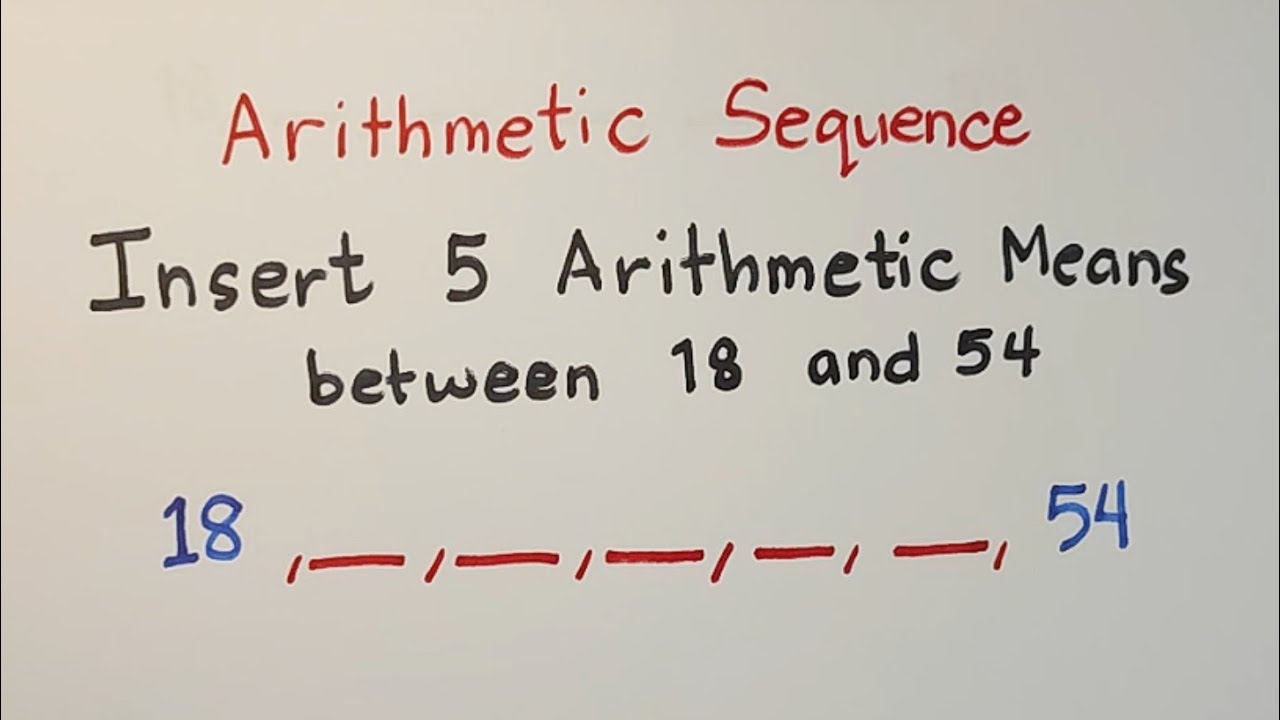Illustrating an Arithmetic Sequence | Grade 10 Math
Summary
TLDRThis educational video explains arithmetic sequences, where each term after the first is obtained by adding a constant, the common difference (d). It demonstrates how to identify arithmetic sequences using examples like 2, 4, 6, 8, 10 (arithmetic) and 1, 4, 9, 16, 25, 36 (not arithmetic). The video also shows how to calculate the first five terms of a sequence given the first term (a1) and common difference, using both positive and negative values for d.
Takeaways
- 🔢 Arithmetic sequences are defined by a constant difference, denoted as 'd', added to each term after the first.
- 📈 The sequence 2, 4, 6, 8, 10 is arithmetic because each term increases by a common difference of 2.
- 🚫 The sequence 1, 4, 9, 16, 25, 36 is not arithmetic as the difference between terms is not constant.
- 📉 The sequence 1, 1, 2, 3, 5, 8 is not arithmetic because the difference between terms varies.
- 🔄 The sequence 3, 7, 11, 15 is arithmetic with a common difference of 4.
- 📊 The sequence 10, 8, 6, 4, 2 is arithmetic with a common difference of -2, indicating a decreasing sequence.
- 📋 To identify if a sequence is arithmetic, calculate the difference between consecutive terms and check for consistency.
- 📝 For a given arithmetic sequence, if the first term (a1) is known, subsequent terms can be found by adding the common difference.
- 📖 If the common difference is positive, each term increases by that amount; if negative, each term decreases.
- 🔄 An example with a1 = 2 and d = 5 results in the sequence 2, 7, 12, 17, 22.
- 🔄 An example with a1 = 30 and d = -6 results in the sequence 30, 24, 18, 12.
Q & A
What is an arithmetic sequence?
-An arithmetic sequence is a sequence where every term after the first is obtained by adding a constant, called the common difference, denoted by the letter d.
How do you determine if a sequence is arithmetic?
-You determine if a sequence is arithmetic by checking if there is a constant number being added or subtracted between each pair of consecutive terms.
What is the common difference in the sequence 2, 4, 6, 8, 10?
-The common difference in the sequence 2, 4, 6, 8, 10 is 2, as each term increases by 2.
Is the sequence 1, 4, 9, 16, 25, 36 an arithmetic sequence?
-No, the sequence 1, 4, 9, 16, 25, 36 is not an arithmetic sequence because the difference between consecutive terms is not constant.
What is the common difference in the sequence 3, 7, 11, 15?
-The common difference in the sequence 3, 7, 11, 15 is 4, as each term increases by 4.
Is the sequence 10, 8, 6, 4, 2 an arithmetic sequence?
-Yes, the sequence 10, 8, 6, 4, 2 is an arithmetic sequence because it decreases by a constant value of 2.
What does the common difference being negative indicate in an arithmetic sequence?
-A negative common difference indicates that each term in the sequence is obtained by subtracting a constant value from the previous term.
How do you calculate the first five terms of an arithmetic sequence with a1 = 2 and d = 5?
-You calculate the first five terms by starting with the first term (a1 = 2) and adding the common difference (d = 5) to each subsequent term: 2, 2+5=7, 7+5=12, 12+5=17, 17+5=22.
What is the first term and common difference of the arithmetic sequence 30, 24, 18, 12?
-The first term (a1) is 30 and the common difference (d) is -6 for the sequence 30, 24, 18, 12.
How can you identify if a sequence is arithmetic mentally?
-You can identify if a sequence is arithmetic mentally by quickly calculating the difference between consecutive terms and checking if it remains constant.
What is the significance of the common difference in an arithmetic sequence?
-The common difference is significant in an arithmetic sequence as it determines the pattern of increase or decrease between consecutive terms.
Outlines

This section is available to paid users only. Please upgrade to access this part.
Upgrade NowMindmap

This section is available to paid users only. Please upgrade to access this part.
Upgrade NowKeywords

This section is available to paid users only. Please upgrade to access this part.
Upgrade NowHighlights

This section is available to paid users only. Please upgrade to access this part.
Upgrade NowTranscripts

This section is available to paid users only. Please upgrade to access this part.
Upgrade NowBrowse More Related Video

GCSE Maths - Types of Number Sequences - Arithmetic vs Geometric

Introduction to Sequences

Finding the Arithmetic Means - Arithmetic Sequence Grade 10 Math

MATH 10 : DIFFERENTIATING GEOMETRIC SEQUENCE FROM AN ARITHMETIC SEQUENCE (Taglish)

Sequences, Factorials, and Summation Notation

Arithmetic Sequence (Explicit Formula)
5.0 / 5 (0 votes)